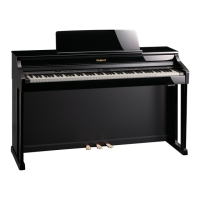Practicing
Recording the Song You’re Practicing
It’s easy to record your own performances.
You can play back a recorded performance to check your playing, or perform along with a recorded performance.
The unit lets you record in the following ways.
Type of recording Explanation
SMF recording
Parts will be separate.
You can re-record a specic portion of the song.
You can overdub.
* Normally, you should use SMF recording.
Audio recording
Your performance will be recorded as audio data. The recorded song can be used on your computer.
* In order to use audio recording, you must connect a USB ash drive (sold separately) to the USB memory port (p. 10).
* SMFs (Standard MIDI Files) use a standard format for music le that was formulated so that les containing music le could be widely
compatible, regardless of the manufacturer of the listening device. An enormous variety of music is available, whether it be for listening, for
practicing musical instruments, for Karaoke, etc.
HP505 only
* Thanks to its multiple number of speakers, each of which can be used to play a dierent portion of the overall sound, the HP505 is capable
of producing piano sounds that possess great depth and seem to have three-dimensional presence.
Such eects are produced when you play something on the keyboard, or when you play back a song that's been recorded as an SMF.
However, when you make an audio recording, the song will consist of two channels (stereo), and such eects cannot be reproduced.
SMF Recording
To record a new song, proceed as follows.
This method is convenient when you simply want to record your performance as easily as possible.
Getting ready to record
1.
Select the tone that you want to use for performing (p. 16).
2. Press the [ ] (Rec) button.
The [ ] (Rec) button will light, the [ ] (Play/Stop) button will blink, and the unit will enter
recording-standby mode.
If you decide not to record, press the [
] (Rec) button once again.
3. If desired, sound the metronome (p. 24).
MEMO
If you change the metronome’s tempo and time signature, they will be recorded with the song, allowing the metronome to sound correctly during
playback.
Starting/stopping recording
1.
Press the [ ] (Play/Stop) button.
A two-measure count will be heard (the measure number will be shown as “-2”
then “-1” in the lower right of the display), and then recording will start.
When recording starts, the [
] (Rec) button and [ ] (Play/Stop) button
will light.
MEMO
You can also initiate recording by simply playing the keyboard. If you initiate recording by playing the keyboard, a count will not be sounded.
2. Press the [ ] (Play/Stop) button.
Recording will stop, and a message will ask whether you want to save your performance.
2
1 2
31
Operation Guide Panel Descriptions Before You Play Performing Practicing
Convenient Functions
Appendix
Function Mode

